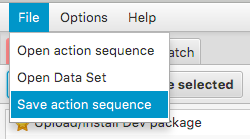-
Notifications
You must be signed in to change notification settings - Fork 14
Action Managment
The 2.0 version of Curly introduced additional action management features:
- Favorites: Commonly-used actions, including custom actions, can be retained and are easier to find
- Load/Save action sequences: This allows a set of actions to be reused across curly sessions

In this example, a new action is created based on the "Upload a package AND install" action. Because this action is customized to perform action on a specific package, the name is changed to indicate it is for a "dev" package, but this is merely an example and you'd likely use a less generic name.
At any point, the user clicks on the "Add Favorite" button at the bottom of the window. This marks the action as a favorite, and any future changes to this action will be reflected in the favorites copy as well.

In addition to saving custom actions, this feature allows you to move your favorite actions to the top of the action drop down list for simplifying the work of using your favorite actions. All favorites are indicated in lists using gold star indicators.
You can favorite a pre-defined action without making changes to it as well. If you make changes to the action without changing its name then the favorite will always reflect your changes. If you want to revert back to defaults, remove the favorite using the "Remove favorite" button, create a new action with the defaults, and then add it as a favorite again.

Action lists can be of any length, and setting up these lists can be time-consuming. In order to retain action lists and load them again on another Curly session, use the "Save action sequence" selection from the File menu to save the actions as an XML file. Later on you can load the actions back using "Open action sequence"
Important note: The variable settings are not retained when you save action sequences, but you can edit actions to place default values in the variables. The default values are retained since they are part of the commands defined in actions.